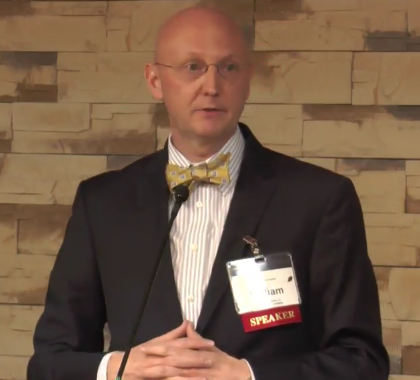What did the American Founders actually intend for the country and does it even matter today?
William Watkins, Jr., as the featured speaker at The Heartland Institute’s Wednesday evening free series of event, spoke about his book, Crossroads for Liberty: Recovering the Anti-Federalist Values of America’s First Constitution. Watkin’s book takes a surprising and thought-provoking look at the American Revolution, the Articles of Confederation, the Constitution and theBill of Rights and asks what we can learn from them.
William Watkins, Jr. is a research fellow at the Independent Institute. He received his B.A. in history and German summa cum laude from Clemson University and his J.D. cum laude from the University of South Carolina School of Law. He is a former law clerk to Judge William B. Traxler, Jr. of the U.S, Court of Appeals for the Fourth Circuit. He has served as a prosecutor and defense lawyer and has practiced in various state and federal courts. Other books include Judicial Monarchs: The Case for Restoring Popular Sovereignty in the United States, and the Independent Institute books, Reclaiming the American Revolution: The Kentucky and Virginia Resolutions and Their Legacy; and Patent Trolls: Predatory Litigation and the Smothering of Innovation.
William Watkins, Jr. introduced by Jim Lakely, Director of Communications at The Heartland Institute
William J. Watkins, in Crossroads for Liberty, rescues the Articles of Confederation from obscurity and condemnation. Watkins does not claim that the Articles constituted a perfect system, but it was a much better system than has been portrayed in history books.
For many years, the Articles of Confederation have been taught in American History class as having created too weak a central government, that it accomplished nothing, and that thankfully it was scrapped and replaced with the U.S. Constitution. Not so, according to Watkins. The Articles needed some reform, but it was a credible document before the Constitutional Convention of 1787.
Watkins likewise cleared up a misconception held by many that the Revolutionary War was all about taxation, brought to a head with the Boston Tea Party. Not true, he said. The argument was about sovereignty. Where did it lie? Did it lie in the British Parliament, or would individual states be able to govern themselves. In the Declaration of Independence, King George III of England was mentioned as the recognized power of authority whose removal was necessary for local state assemblies to achieve local rule.
Articles of Confederation Empowered State Governments
As to why the Articles of Confederation were adopted in the first place, patriot leaders at the time didn’t want some far off government telling them what to do concerning local matters. The Articles of Confederation were designed to let the people of each state govern themselves, while forming an alliance to maintain their independence. Delegates couldn’t serve more than three years out of a six-year period. In this way, legislators would feel the bit of the laws they passed.
In the aftermath of the Revolutionary War, Federalists like Alexander Hamilton began to express dissatisfaction with the Articles of Confederation, thinking it a hopelessly weak common government for the United States that needed replacement. Others, like anti-federalist Patrick Henry, strongly voiced how under the Articles of Confederation its government had put an army in the field for seven years to defeat the mighty British Empire. Said Henry: “Ditching the Articles of Confederation would only lead to an increasingly centralized government that would eventually result in weak states dictated to by a centralized government.”
Using the same reasoning as proclaimed by Patrick Henry, Watkins noted how the goals of the Articles of Confederation had been met:
- Great Britain was defeated. Hadn’t the British Navy ruled the world?
- Self-government and the states had been preserved.
But economic hardship did exist in the aftermath of the Revolutionary War due to the cost of achieving freedom from Great Britain – i.e. hard cash was limited, the protection of the British Navy was lost, as was the right to trade with the British West Indies.
Ratification of Constitution Hinged on a Bill of Rights
Federalists won the argument. Led by Federalist Alexander Hamilton, who believed a Constitution with a federal system of government could accomplish the same thing without the deficiencies in the Articles – and who further argued that because the Articles of Confederation were committed to states’ rights reform of the Articles was not possible — a Constitutional Convention was needed. Subsequently, a Constitution was written during the summer of 1787 in Philadelphia by 55 delegates to a Constitutional Convention that was called ostensibly to amend the Articles of Confederation (1781–89), the country’s first written constitution.
The new Constitution was submitted for ratification to the 13 states on September 28, 1787. It was ratified by nine states in June of 1788, as required by Article VII. The date of March 4, 1789 was set by Congress as to when the new government would begin operating, with the first elections under the Constitution held late in 1788.
Why did four of the 13 states refuse to ratify the Constitution when first submitted to them? As Watkins explained, one of the many points of contention between Federalists and Anti-Federalists over the Constitution is that it lacked a Bill of Rights that would place specific limits on government power. Although nine states had ratified the Constitution by June of 1788, the key states of Virginia and New York would only ratify the Constitution after James Madison promised that a Bill of Rights would be added after ratification. Two states, Rhode Island and North Carolina, refused to ratify without a Bill of Rights. In June 1789, Madison proposed a series of amendments to be debated in the first Congress. These amendments to the United States Constitution (10 of them) became known as the Bill of Rights.
Rough Sailing for the Newly Adopted Constitution of 1787
Watkins enumerated three lies that angered segments of the American population after they had been assured that certain things would not happen with the ratification of the Constitution.
1st lie
Farmers were told that the excise power in the Constitution wouldn’t be used except in unusual situations. The Whiskey Rebellion was a response to the excise tax proposed by Alexander Hamilton, who was Washington’s Secretary of the Treasury in 1791. In January 1791, President George Washington’s Secretary of the Treasury Alexander Hamilton proposed a seemingly innocuous excise tax “upon spirits distilled within the United States, and for appropriating the same.” What Congress failed to predict was the vehement rejection of this tax by Americans living on the frontier of Western Pennsylvania. By 1794, the Whiskey Rebellion threatened the stability of the nascent United States and forced President Washington to personally lead the United States militia westward to stop the rebels. Learn More
2nd lie
It was the Alien and Sedition Act of 1798, signed into law by President John Adams, that when put into practice became a black mark on the Nation’s reputation. People were lied to again. In direct violation of the Constitution’s guarantee of freedom of speech, the Sedition Act permitted the prosecution of individuals who voiced or printed what the government deemed to be malicious remarks about the president or government of the United States. Fourteen Republicans, mainly journalists, were prosecuted, and some imprisoned, under the act.
3rd lie
Alexander Hamilton’s claim that the Articles of Confederation were useless, and the only remedy was to draft a new governing document.
Anticipated Fears about 1787 Constitution Were Not Speculative in Nature
Watkins suggested that our Constitution of 1787 is not the greatest gift of political science that the world has ever seen.
1. How can one size fit all with a nation of 50 states?
2. How can a national government be in charge of 300-plus million Americans?
3. Shouldn’t individual states serve as laboratories of experimentation and policy making?
4. Does James Madison’s worry about the accumulation of power, which, he said “in one place is paramount to tyranny,” seem justified?
5. How can “We the People” monitor those we elect given the super-sized districts they represent? Watkins believes that the present system of limiting the House of Representatives to only 435 members is detrimental to limited government, for as the population expands those representatives become increasing disconnected to the very people they are supposed to be representing.
6. Can representative government even exist in a country of this size?
A massive shift of power happened when Senate members were elected. The Seventeenth Amendment to the United States Constitution – proposed by the 62nd Congress in 1912 – established the popular election of United States Senators by the people of the states. The amendment supersedes Article I, §3, Clauses 1 and 2 of the Constitution, under which senators were elected by state legislatures.
As Watkins stated, the Founding Father reasoned that only licentious behavior and luxury could destroy the Constitution. Some 230 years later, this long-ago fear has been realized, as the founding principles of this nation have been eroded and cast aside in the interim.
Human nature is flawed, and, as noted by Jefferson, “the chains of the Constitution” were needed, but what can now be done? As reasoned by Watkins, we certainly cannot return to the Articles of Confederation, nor is it possible to return to the Constitution, at least not as it was first conceived by our Founding Fathers.
Watkins suggested that general education is needed so the public, and especially young people, come to realize that the Socialism spouted by Bernie Sanders, embraced without even realizing what was being offered, is an evil and unworkable system of government.
Selected Questions and Answers
Q: Why was the American Revolution different from revolutions in other nations?
A: Our revolution was based on the Rule of Law, whether sovereignty existed with the King of England or with state assemblies, which gave us a foundation upon which to base our government. The American people perceived that things were out of kilter and had to be restored.
Q: Is an Article V Convention a realistic plan? Is this an efficient way to address some of the flaws in our Constitution?
A: Watkins didn’t think it wise to take what we have and then trust that the results will be positive. As Watkins notes in his book: “There never have been enough states requesting a convention and this is for good reason. First, no one knows whether such a convention would be limited or unlimited in its scope. If the states requested a convention to consider proposing a balanced budget amendment, would the convention be prohibited from also offering amendments on matters such as abortion or capital punishment?” Watkins adds, “A convention could result in much chaos and constitutional uncertainty.”
“On paper,” Watkins laments, “they [the states] could demand a convention, but in reality Congress holds all the cards when it comes to constitutional change.” Instead, Watkins argues that “the states need the ability to propose and consider amendments without the involvement of the national legislature or the risk associated with a convention.”
Q: Why the need for the Bill of Rights?
A: People and states were fearful of a new federal government having too much power.
[Originally Published at Illinois Review]





